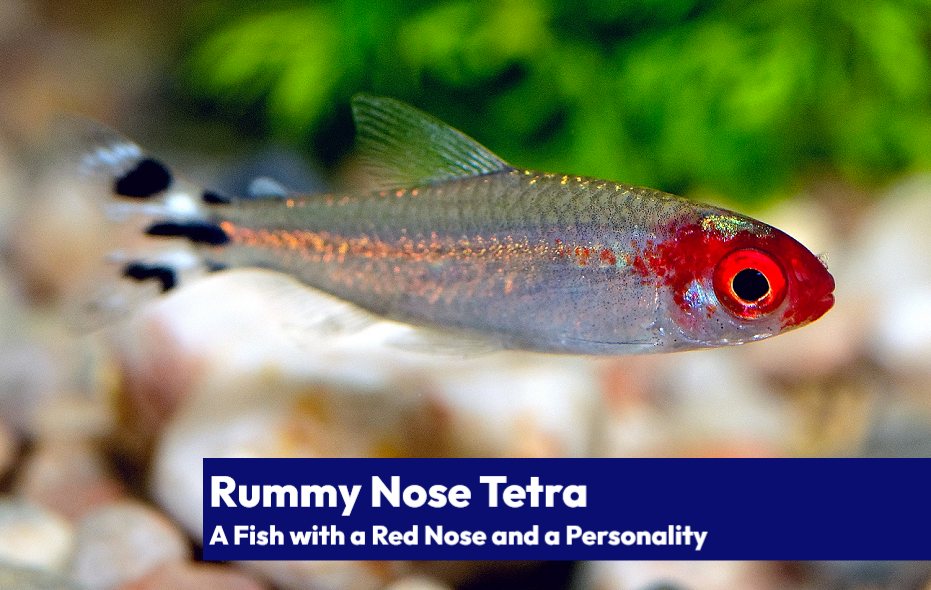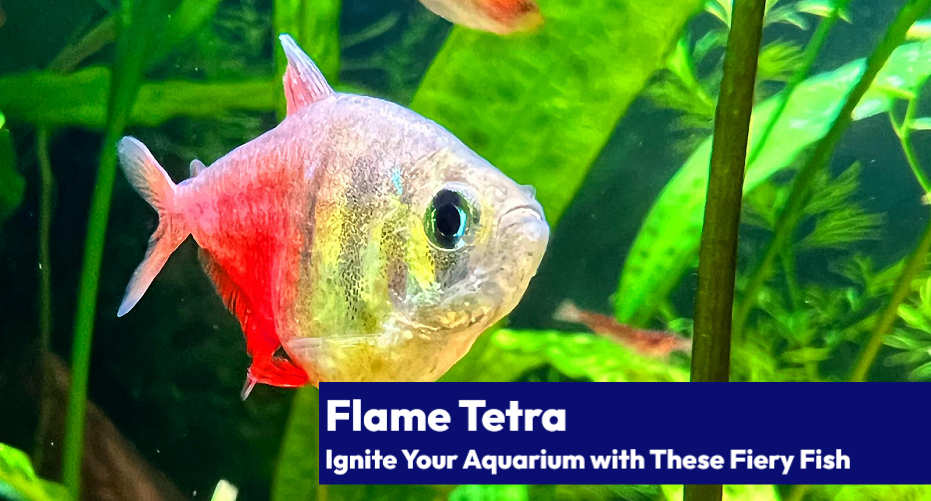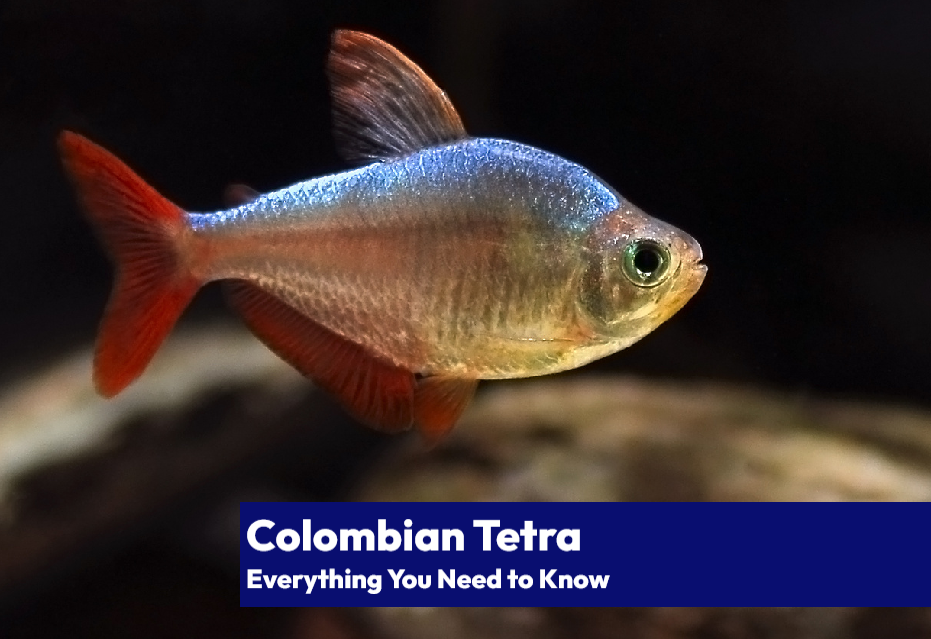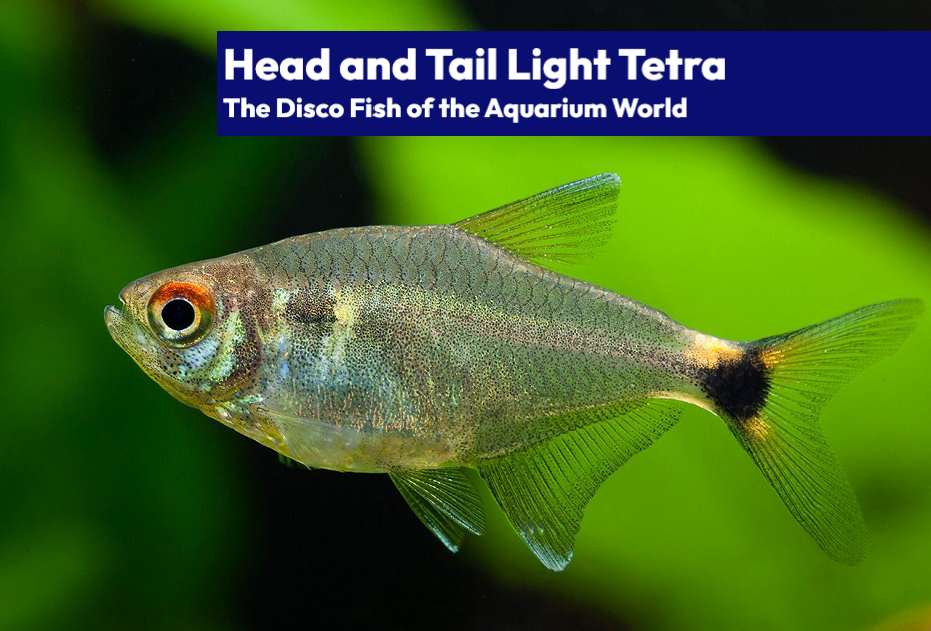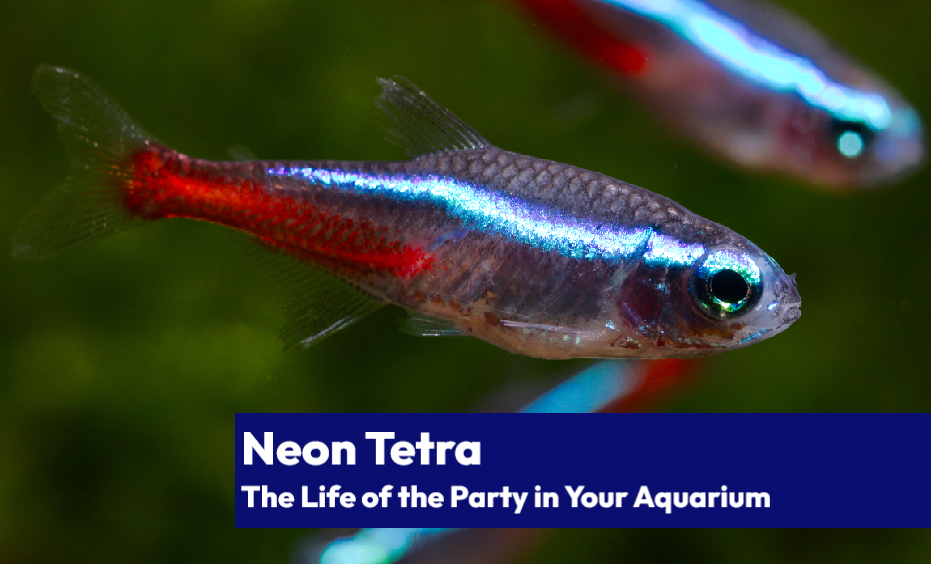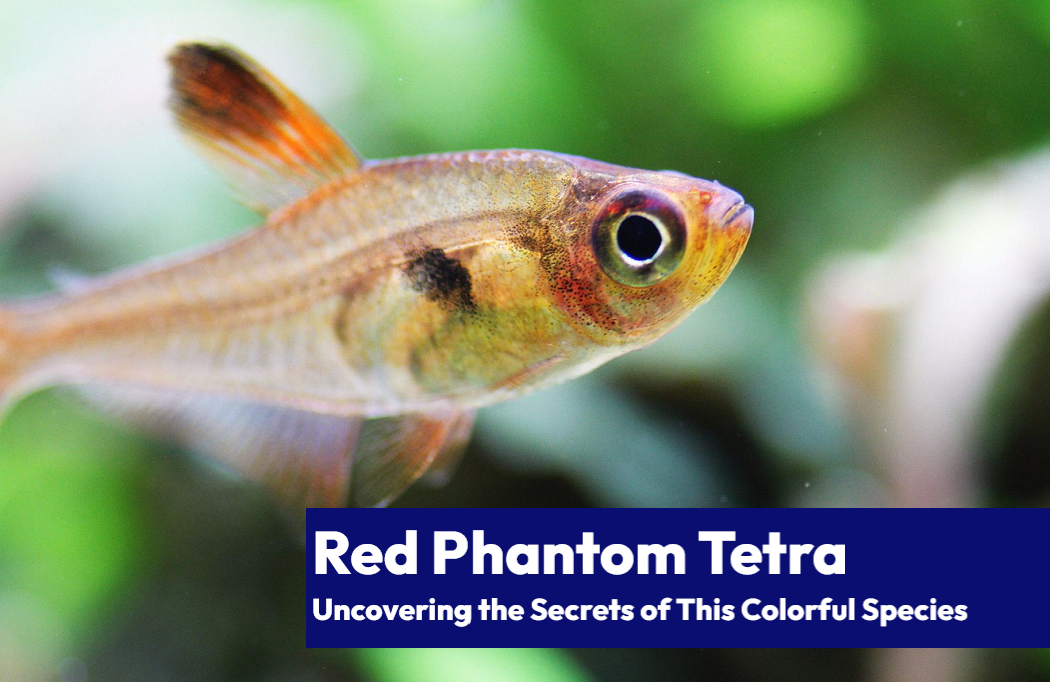Ready to add an aesthetic touch to your aquarium? Look no further than the cardinal tetra! With their iridescent bodies and fiery red fins that shimmer like a rainbow, you’ll find yourself constantly drawn to their tank, just to catch a glimpse of their beauty.
That beauty is not just skin deep however. These fish are hardy making them a great choice for both novice and experienced aquarists alike. You’ll love their peaceful demeanor and their unique behavior, making them not only a visual delight, but also a pleasure to keep and care for.
In this article, we’ll dive into everything you need to know about these vibrant little fish, including their lifespan, tank requirements, diet, suggested tankmates, breeding information, and more.
| Care Data | Description |
|---|---|
| Scientific Name | Paracheirodon axelrodi |
| Maximum Size | 1.5 inches (3.8 cm) |
| pH Range | 5.5 – 7.5 |
| Temperature Range | 72 – 82°F (22 – 28°C) |
| Water Hardness | 2 – 10°dGH |
| Tank Size | 10 gallons (38 L) minimum |
| Water Movement | Low to moderate |
| Lighting | Low to moderate |
| Diet | Omnivore, require a varied diet |
| Breeding | Egg scatterer, can be difficult to breed in captivity |
| Temperament | Peaceful, best kept in schools of 6 or more |
| Compatibility | Can be kept with other small, peaceful fish such as neon tetras and rasboras |
Appearance
The cardinal tetra is a small, slender fish that possesses a silver-blue iridescent body with a bright red band running along the base of their dorsal fin. Their fins are also red and transparent, giving them a striking and unique appearance.

Lifespan
The cardinal tetra has a lifespan of around 3-5 years with proper care.
Average Size and Growth Rate
The average size of a fully grown cardinal tetra is about 1.5 inches (3.8 cm). They have a slow growth rate, reaching sexual maturity at around 8-10 months. It can take up to 2 years for their to reach their maximum size.
Tank Size
A group of cardinal tetras should be kept in a tank of at least 10 gallons (38 L) with a cover of floating plants. 20 gallons is ideal for a larger group.

Water Parameters
Ideal water parameters for cardinal tetras include a pH between 6.0 and 7.0, a water temperature between 72 and 82°F (22-28°C) and a water hardness between 2-10 dGH.
Diet
Cardinal tetras are omnivorous and should be fed a diet of both live and frozen foods, such as bloodworms, brine shrimp, and daphnia, as well as high-quality flakes or pellets.
| Food Option | Description |
|---|---|
| Live Brine Shrimp | Live brine shrimp are a highly nutritious and protein-rich food option for cardinal tetras. They contain essential fatty acids and minerals that promote healthy growth and vibrant coloration. |
| Frozen Bloodworms | Frozen bloodworms are a great option for cardinal tetras as they are high in protein and fat. They can also help to stimulate breeding in these fish. |
| Micro Pellets | Micro pellets are a great all-around food option for cardinal tetras as they are formulated to provide a balanced diet for these fish. They are small and easy for the fish to eat, and also promote healthy growth and coloration. |
| Flake Food | Flake food is a convenient option for cardinal tetras as it is easy to store and can be fed to the fish daily. It is formulated to provide a balanced diet for these fish and is also a great option for those who don’t want to feed live or frozen food. |
| Daphnia | Daphnia is a small freshwater crustacean that is a great food option for cardinal tetras. They are high in protein and fat, and also provide essential vitamins and minerals that promote healthy growth and coloration. |
| Cyclops | Cyclops is a small freshwater crustacean that is similar to Daphnia. They are a great food option for cardinal tetras as they are high in protein and fat, and also provide essential vitamins and minerals that promote healthy growth and coloration. |
| Tubifex worms | Tubifex worms are a great food option for cardinal tetras as they are high in protein and fat, and also provide essential vitamins and minerals that promote healthy growth and coloration. They are also easy to store and feed. |
| Freeze-dried Bloodworms | Freeze-dried bloodworms are a great food option for cardinal tetras as they are high in protein and fat, and also provide essential vitamins and minerals that promote healthy growth and coloration. They are also easy to store and feed. |
Housing Requirements and What to Put in Their Tank
Cardinal tetras prefer a heavily planted tank with plenty of hiding spots and open swimming spaces. They also appreciate a dark substrate and low lighting.
Behavior and Temperament
Cardinal tetras are peaceful fish that can be kept with other similarly sized and tempered fish. They are shy and prefer to be in schools of at least six individuals.

Breeding
Breeding cardinal tetras requires advanced care and is not for the average hobbyist. It is possible however, and we’ve provided step-by-step instructions below for the advanced reader who would like to dig deep into the breeding process.
- Setting up a breeding tank
In order to breed Cardinal tetras, you’ll a separate breeding tank with a volume of about 5 gallons, with a water level of approximately 5 cm. The breeding tank should be well cycled with stable parameters, with a temperature range of 76-78F, a pH range of 5.0-5.5, and a dGH level of less than 3. You’ll likely need RO water to achieve this condition unless your tap water is extremely soft. Once the spawning group is introduced, the tank should also be shaded on all sides to prevent all light from entering. The eggs and fry are photosensitive and the parents will likely not attempt to spawn at all unless it completely dark. Keep the eggs and fry from being exposed to light at all costs. The bottom of the tank should be covered in java moss and leaf litter like indian almond leaves, to provide a to provide cover for the eggs and fry and create blackwater conditions, release tannins, and lower pH level similar to their natural breeding environment. - Selecting the breeders
The challenge in breeding Cardinal tetras begins early at the selection of adult breeders. The sexual dimorphism of the fish is not expressed, making it difficult to determine the males from the females. However, males are generally slimmer than females and the edge of their anal fin is convex. It’s important to pick a healthy and active pair for breeding. - Preparing for breeding
A week before breeding, the pair should be plentifully fed and conditioned with a variety of live foods. This will help to ensure that they are in good health and ready to spawn. Once the pair is ready, they should be transferred to the breeding tank. The male will begin a long courtship of the female, which can last up to 7 days before spawning occurs but can vary dramatically depending on the behavior of the fish. - Spawning and egg care
The female will lay between 130 and 500 eggs in the evening hours, and spawning can continue late into the night. The male will fertilize the eggs as they are laid. It is important to remove the breeders from the tank immediately after spawning to prevent them from eating the eggs. The eggs will hatch in approximately 24 hours and the fry will live off of their yolk sac for an additional 4-5 days. You’ll want to check every 8-12 hours for evidence of a spawn. - Fry care and development
Once the eggs have hatched and the fry are free swimming, they should be fed infusoria, rotifers, hardboiled egg yolk, or commercially prepared fry food. As they grow, they should be fed freshly hatched brine shrimp. The young tetra fry are highly photo-sensitive, so it is important to continue keeping the lighting in the tank subdued and to use floating plants to provide cover and shade. The fry will develop quickly, with the light stripe appearing at 3 weeks of age and the adult color appearing at 5 weeks of age. Cardinal tetras will reach maturity at about 8-10 months of age.
For hands on exploration and instruction that exhaustively covers the breeding process, we’ve included the following 3 part video from Avatar Aquatics that comprehensively covers breeding cardinal tetras from start to finish. Special thanks to them for taking the time to build these useful tutorials for hobbyists!
Part 1: Breeding Tank Setup
Part 2: Cardinal Tetra Fry Care
Part 3: Growth
Tankmates
Cardinal tetras can be kept with other small, peaceful fish such as neon tetras, ghost shrimp, and otocinclus catfish. Avoid keeping them with larger, more aggressive fish that may bully or eat them.
| Tankmate | Description |
|---|---|
| Neon Tetra | Neon tetras are a classic companion for cardinal tetras. They have a similar size and coloration, and they both prefer similar water conditions. |
| Ember Tetra | Ember tetras are a small, brightly colored fish that can complement cardinal tetras well. They prefer slightly cooler water temperatures and are peaceful fish. |
| Rummy Nose Tetra | Rummy nose tetras are another small, peaceful fish that can be a great tankmate for cardinal tetras. They have a distinctive red nose and tail and can add a pop of color to the tank. |
| Harlequin Rasbora | Harlequin rasboras are a small, active fish that can be a great addition to a tank with cardinal tetras. They have a striking coloration and are peaceful and easy to care for. |
| Guppies | Guppies are a hardy and adaptable species that can be a great addition to a tank with cardinal tetras. They come in a variety of colors and are peaceful, but active fish. |
| Ghost Shrimp | Ghost shrimp are a great addition to a tank with cardinal tetras. They are peaceful, hardy, and help keep the tank clean. |
| Corydoras Catfish | Corydoras catfish are a great addition to a tank with cardinal tetras. They are peaceful, hardy, and help keep the tank clean. They have a friendly and peaceful nature. |
| Bamboo Shrimp | Bamboo shrimp are a great addition to a tank with cardinal tetras. They are peaceful, hardy, and help keep the tank clean. They also have an interesting and unique appearance. |
| Amano Shrimp | Amano shrimp are a great addition to a tank with cardinal tetras. They are peaceful, hardy, and help keep the tank clean. They are known as one of the best algae eating invertebrates in the hobby. |
| Siamese Algae Eater | Siamese Algae Eaters are a great addition to a tank with cardinal tetras. They are peaceful, hardy, and help keep the tank clean. They also help keep algae growth under control. |
Diseases and Illnesses
Even with proper care and maintenance, these fish can fall victim to a variety of illnesses and diseases. In this article, we will explore the six most common illnesses and diseases found in cardinal tetras and discuss the best ways to diagnose and treat them.
- Neon Tetra Disease (NTD)
One of the most common illnesses found in cardinal tetras, Neon Tetra Disease (NTD) is caused by a parasitic infection known as Pleistophora hyphessobryconis. Symptoms include a curved spine, loss of color, and eventual death. Treatment for NTD includes the use of the medication metronidazole, which can be added to the tank water. It’s important to note that while NTD is primarily found in neon tetras, it can also infect cardinal tetras and other closely related species. One suggested product for treatment is Seachem Metroplex. - Fin Rot
Fin rot is a bacterial infection that causes the fins and tail of the fish to become frayed and eventually disintegrate. This can be caused by poor water quality, injury, or stress. To diagnose fin rot, look for frayed or disintegrating fins and tail, and a general lack of vitality. Treatment includes improving water quality and adding the antibiotic oxytetracycline to the tank water. We recommend API FIN & BODY CURE. - Ichthyophthirius multifiliis (Ich)
Ich, commonly known as “ich,” is a parasitic infection caused by a single-celled organism. Symptoms include small white spots on the skin, fins, and gills. Ich can be spread through contact with infected fish or by introducing contaminated water into the tank. To diagnose ich, look for the characteristic white spots on the fish. Treatment includes increasing the temperature of the water to 86°F (30°C) for a week and adding the medication ichthyophthirius multifiliis to the tank water. We recommend API Liquid Super Ick Cure. - Swim Bladder Disease
Swim bladder disease is a condition that affects the fish’s ability to maintain proper buoyancy. Symptoms include an inability to swim upright and a bloated appearance. This can be caused by overfeeding, constipation, or a genetic predisposition. To diagnose swim bladder disease, look for an inability to swim upright and a bloated appearance. Treatment includes reducing the amount of food given to the fish and adding the medication metronidazole to the tank water. Use API MELAFIX. - Columnaris
Columnaris is a bacterial infection that causes gray or white patches on the skin, fins, and gills. It can be caused by poor water quality or a weakened immune system. To diagnose columnaris, look for gray or white patches on the skin, fins, and gills. Treatment includes improving water quality and adding the antibiotic oxytetracycline to the tank water. The product API FIN & BODY CURE has this medication and is a good option. - Dropsy
Dropsy is a symptom rather than a specific disease and is characterized by a swollen belly, sunken eyes, and a pinecone-like appearance. It can be caused by a variety of underlying issues such as bacterial infection, kidney failure, or cancer. To diagnose dropsy, look for a swollen belly, sunken eyes, and a pinecone-like appearance. Treatment includes addressing the underlying cause, such as administering antibiotics or addressing any other underlying health conditions. A good product for treating Dropsy is Seachem Kanaplex.
History and Origin
Cardinal tetras, also known as Paracheirodon axelrodi, are a small, brightly colored fish that are native to South America. They are a popular species in the aquarium trade due to their vibrant red and blue coloration and small size, making them suitable for even the smallest of tanks.

The origin and natural habitat of the cardinal tetra can be traced back to the upper Orinoco and Negro rivers in Venezuela and Brazil. These fish are known to inhabit the tributaries and smaller streams that flow into the main river systems. The cardinal tetra is a freshwater fish and can be found in a variety of habitats including clear and black water, as well as in flooded forests.
The cardinal tetra was first described by the German ichthyologist Herbert R. Axelrod in 1956 in his magazine “Tropical Fish Hobbyist” where he was able to classify this species after years of research. The fish was named after him, with the scientific name Paracheirodon axelrodi.
Working alongside Axelrod was George S. Myers who was a renowned ichthyologist of the time and made great contributions in the taxonomy and systematics of tetras. As a close colleague of Herbert R. Axelrod, they worked on several projects and publications, Myers contributed to the publication by providing detailed information on the natural history and distribution of various species of tetras, including the Cardinal tetra. His work helped to establish the scientific foundations for the breeding and keeping of these fish in captivity and helped to popularize them in the aquarium hobby.
The popularity of the cardinal tetra in the aquarium trade can be attributed to its breathtaking coloration and small size. Its pronounced red and blue hues make it a popular choice for both novice and experienced fish keepers alike. The fish’s small size also makes it suitable for smaller tanks and community aquariums and is used by aquascapers worldwide to create charming contrasts.
In the wild, the cardinal tetra is known to form large schools and is a peaceful species. This behavior has been observed in captivity as well, making it a popular choice for community tanks. The fish is easy to care for and will thrive in a wide variety of water conditions, making it an ideal fish for a variety of aquarists and fishkeepers.

Now you’re an expert on Cardinal tetra care, get out there and start building your own school of these ravishing little fish.With proper care and a healthy diet, your cardinal tetras will thrive and bring a splash of color to your aquarium for years to come.
Useful Products for Cardinal Tetra Care
Below we’ve crafted a list of 15 of the best products that will help you build a great habitat for cardinal tetras, and maintain it properly.
| Product Name | Category | Product Link | Description |
|---|---|---|---|
| Fluval Flex 15g Aquarium | Aquarium | View on Amazon | 15 gallon all-in-one aquarium with built-in filtration, lighting, and heating. Great for starting out with Cardinal Tetras. |
| Aqueon 10g Tank | Aquarium | View on Amazon | Durable glass aquarium, available in various sizes 10 gallons and larger. |
| Fluval M200 Submersible Heater | Heater | View on Amazon | Adjustable, submersible aquarium heater. Suitable up to 65 gallons. |
| OASE Indoor Aquatics Filtosmart 60 | Filter | View on Amazon | Power canister filter appropriate for aquariums up around 20 gallons. |
| Tetra Whisper Air Pump | Air Pump | View on Amazon | Quiet and efficient air pump for aquariums. |
| Pawfly 1.5 Inch Air Stone Disc | Air stone | View on Amazon | Air stone for fine mist bubbles and water movement. |
| Fluval Plant and Shrimp Stratum | Decor | View on Amazon | A great planted tank substrate to create an ideal aquascape for cardinal tetras. |
| Lifegard Aquatics Aquascaping Seiryu Stone | Decor | View on Amazon | Natural stones for aquarium decoration and pH balance. |
| Xtreme Aquatic Foods Nano Fish Food | Food | View on Amazon | High-protein commercial fish meal good for Cardinal tetras. |
| Fluval Bug Bites | Food | View on Amazon | Freeze-dried bloodworm food, packed with protein for Cardinal tetras. |
| Python Aquarium Vacuum | Tool | View on Amazon | Easy-to-use vacuum for water changes, cleaning aquarium gravel and debris. |
| Java Moss | Plants | View on Amazon | Low-maintenance, hardy plant for aquarium. |
| Java Fern | Plants | View on Amazon | Low-maintenance, hardy plant for aquarium. |
| Anubias Plant | Plants | View on Amazon | Low-maintenance, hardy plant for aquarium. |
| Cryptocoryne Wendtii | Plants | View on Amazon | Low-maintenance, hardy plant for aquarium. |
Frequently Asked Questions
Q: How big do cardinal tetras get?
A: Cardinal tetras typically grow to be about 1.5 inches in length.
Q: How many cardinal tetras can be kept in a 20 gallon tank?
A: A 20 gallon tank can comfortably hold around 10-12 cardinal tetras. It is important to keep in mind that the more fish you have in a tank, the more filtration, water changes, and maintenance will be required to keep the water conditions optimal for the fish.
Q: Are cardinal tetras hardy fish?
A: Yes, cardinal tetras are considered to be hardy fish and are relatively easy to care for. They are a good option for beginner fish keepers. These fish often are frequently sold diseased due to poor overcrowded conditions between exporters, wholesalers, and local fish stores, so it’s important to consider quarantining them and medicate them as necessary before introducing them to your main tank.
Q: How long do cardinal tetras live?
A: Cardinal tetras have a lifespan of around 3-5 years, depending on the care they receive. Proper water conditions, nutrition, and regular maintenance can help prolong their life.
Q: How many cardinal tetras can be kept in a 10 gallon tank?
A: A 10 gallon tank can comfortably hold around 5-6 cardinal tetras. Optimally, you’d want to keep these fish in at least 20 gallons of water.
Q: Are cardinal tetras fin nippers?
A: Cardinal tetras are not known to be fin nippers and are generally considered to be peaceful fish. However, if the tank conditions are poor or if the fish are overcrowded, they may become stressed and start nipping fins.
Q: Can cardinal tetras live with bettas?
A: Cardinal tetras and bettas can live together, but note that bettas are territorial fish and may become aggressive towards the cardinal tetras. A larger tank with plenty of hiding spots and plants can help to minimize this behavior.
Q: Can cardinal tetras live with neon tetras?
A: Yes, cardinal tetras and neon tetras can live together. They are both peaceful fish that are often kept in community tanks. Neon tetras are sensitive to water conditions, so it is important to keep the water conditions optimal for both species.
Q: How many cardinal tetras can be kept in a 20 gallon tank?
A: A 20 gallon tank can comfortably house a group of around 10-15 cardinal tetras.
Q: Do cardinal tetras lay eggs?
A: Yes, cardinal tetras are egg-laying fish. They will lay their eggs on surfaces such as leaves, plants, or directly on the substrate.

Tim Priest, a renowned aquarium expert with over 15 years of experience in aquatic gardening and fish education, is dedicated to helping enthusiasts create stunning and thriving aquatic environments. As the founder of LearnTheAquarium.com, Tim shares his wealth of knowledge, passion, and expertise through engaging articles, educational resources, and personalized advice.
Discover the secrets to creating captivating underwater landscapes and maintaining healthy aquatic ecosystems. Join Tim on an exciting journey and let your aquarium adventure begin!

